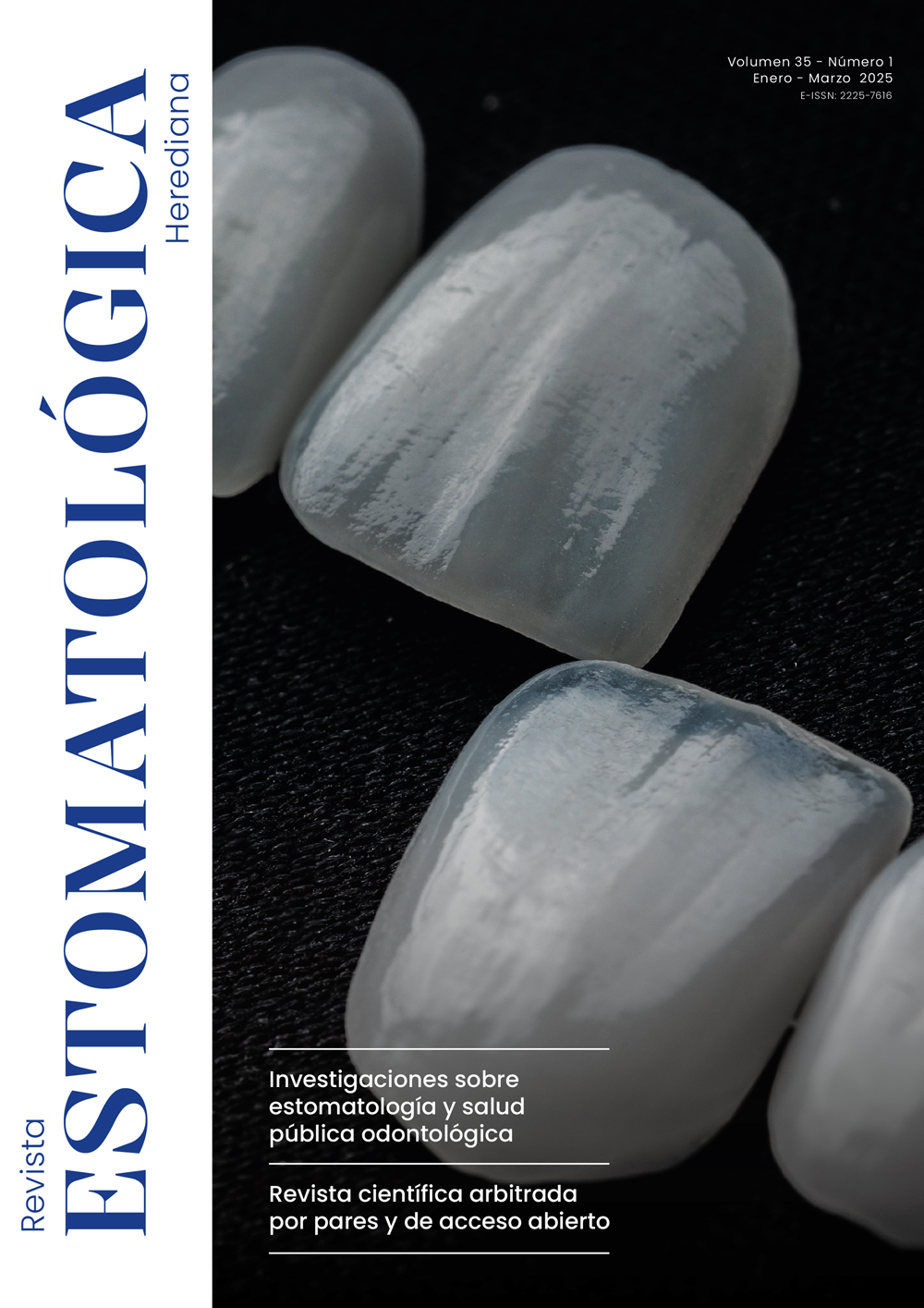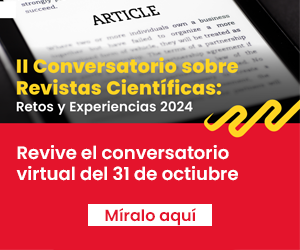Comparison of the mechanical properties and depth of cure of bulk-fill and bioactive composite resins
DOI:
https://doi.org/10.20453/reh.v35i1.6247Keywords:
hardness, polymerization, composite resinsAbstract
Objective: To compare in vitro the mechanical properties and depth of cure of bioactive bulk-fill resins versus bulk-fill composite resins. Materials and methods: An in vitro experimental study was conducted with 48 blocks of three types of resin. Each block received a load of 500 g for 30 seconds and was photopolymerized with a VALO® Cordless-Ultradent unit (1500 mW/cm2) for 4 seconds. Microhardness was evaluated using the Vickers hardness test, employing a calibrated LG® HV-1000 hardness tester. For statistical analysis, the Student's t-test and the non-parametric Kruskal-Wallis test were applied, considering statistical significance if p < 0.05. Results: The bioactive resin Beautifil® Bulk (BB) showed the highest microhardness, reaching a mean value of 55.1 VH (p < 0.01), followed by the resins Tetric® N-Ceram Bulk Fill (TNCBF) with 44.9 VH and Tetric® N-Flow Bulk Fill (TNFBF) with 28.8 VH. The TNFBF bulk-fill resin showed the highest compressive strength, with a mean of 222.4 MPa (p < 0.01), compared to 173.5 MPa for the TNCBF moldable resin and 129.7 MPa for the flowable BB resin. All three resins achieved a homogeneous mean curing depth of 4.0 mm (p > 0.05). Conclusions: The BB bioactive resin showed greater microhardness compared to moldable and flowable bulk-fill resins, while the TNFBF flowable bulk-fill resin showed the highest compressive strength. All three resins had similar values in terms of curing depth.
Downloads
References
Pereira RA, Araujo PA, Castañeda-Espinosa JC, Mondelli RF. Comparative analysis of the shrinkage stress of composite resins. J Appl Oral Sci [Internet]. 2008; 16(1): 30-34. Disponible en: https://doi.org/10.1590/s1678-77572008000100007
Park J, Chang J, Ferracane J, Lee IB. How should composite be layered to reduce shrinkage stress: incremental or bulk filling? Dent Mater [Internet]. 2008; 24(11): 1501-1505. Disponible en: https://doi.org/10.1016/j.dental.2008.03.013
Leprince JG, Palin WM, Vanacker J, Sabbagh J, Devaux J, Leloup G. Physico-mechanical characteristics of commercially available bulk-fill composites. J Dent [Internet]. 2014; 42(8): 993-1000. Disponible en: https://doi.org/10.1016/j.jdent.2014.05.009
Vianna-de-Pinho MG, Rego GF, Vidal ML, Alonso RC, Schneider LF, Cavalcante LM. Clinical time required and internal adaptation in cavities restored with bulk-fill composites. J Contemp Dent Pract [Internet]. 2017; 18(12): 1107-1111. Disponible en: https://doi.org/10.5005/jp-journals-10024-2184
Strini BS, Marques JF, Pereira R, Sobral-Souza DF, Pecorari VG, Liporoni PC, et al. Comparative evaluation of bulk-fill composite resins: knoop microhardness, diametral tensile strength and degree of conversion. Clin Cosmet Investig Dent [Internet]. 2022; 14: 225-233. Disponible en: https://doi.org/10.2147/ccide.s376195
Abuljadayel R, Mushayt A, Al Mutairi T, Sajini S. Evaluation of bioactive restorative materials’ color stability: effect of immersion media and thermocycling. Cureus [Internet]. 2023; 15(8): e43038. Disponible en: https://doi.org/10.7759/cureus.43038
Tongtaksin A, Leevailoj C. Battery charge affects the stability of light intensity from light-emitting diode light-curing units. Oper Dent [Internet]. 2017; 42(5): 497-504. Disponible en: https://doi.org/10.2341/15-294-l
Spajić J, Prskalo K, Šariri K, Par M, Pandurić V, Demoli N. Dimensional changes of glass ionomers and a giomer during the setting time. Acta Stomatol Croat [Internet]. 2018; 52(4): 298-306. Disponible en: https://doi.org/10.15644/asc52/4/3
Colak H, Ercan E, Hamidi MM. Shear bond strength of bulk-fill and nano-restorative materials to dentin. Eur J Dent [Internet]. 2016; 10(1): 40-45. Disponible en: https://doi.org/10.4103/1305-7456.175697
Mandhalkar R, Paul P, Reche A. Application of nanomaterials in restorative dentistry. Cureus [Internet]. 2023; 15(1): e33779. Disponible en: https://doi.org/10.7759/cureus.33779
Besinis A, De Peralta T, Tredwin CJ, Handy RD. Review of nanomaterials in dentistry: interactions with the oral microenvironment, clinical applications, hazards, and benefits. ACS Nano [Internet]. 2015; 9(3): 2255-2289. Disponible en: https://doi.org/10.1021/nn505015e
Arif W, Rana NF, Saleem I, Tanweer T, Khan MJ, Alshareef SA, et al. Antibacterial activity of dental composite with ciprofloxacin loaded silver nanoparticles. Molecules [Internet]. 2022; 27(21): 7182. Disponible en: https://doi.org/10.3390/molecules27217182
Ahmed B, Hamama HH, Mahmoud SH. Microshear bond strength of bioactive materials to dentin and resin composite. Eur J Dent [Internet]. 2023; 17(3): 917-923. Disponible en: https://doi.org/10.1055/s-0042-1756692
Sauro S, Makeeva I, Faus-Matoses V, Foschi F, Giovarruscio M, Pires PM, et al. Effects of ions-releasing restorative materials on the dentine bonding longevity of modern universal adhesives after load-cycle and prolonged artificial saliva aging. Materials [Internet]. 2019; 12(5): 722. Disponible en: https://doi.org/10.3390/ma12050722
Ebaya MM, Ali AI, Mahmoud SH. Evaluation of marginal adaptation and microleakage of three glass ionomer-based class V restorations: in vitro study. Eur J Dent [Internet]. 2019; 13(4): 599-606. Disponible en: https://doi.org/10.1055/s-0039-3401435
Sajini SI, Alshawi BA, Alharbi LM. Assessment of remineralisation potentials of bioactive dental composite using an in-vitro demineralised dentine model. J Taibah Univ Med Sci [Internet]. 2022; 17(4): 640-647. Disponible en: https://doi.org/10.1016/j.jtumed.2021.12.004
Nagi SM, Moharam LM, Zaazou MH. Effect of resin thickness, and curing time on the micro-hardness of bulk-fill resin composites. J Clin Exp Dent [Internet]. 2015; 7(5): e600-e604. Disponible en: https://doi.org/10.4317/jced.52536
Samuel A, Raju R, Sreejith KB, Kalathil BM, Nenavath D, Chaitra VS. Comparative evaluation of the surface hardness of different esthetic restorative materials: an in vitro study. J Pharm Bioallied Sci [Internet]. 2020; 12(Suppl 1): S124-S128. Disponible en: https://doi.org/10.4103/jpbs.jpbs_40_20
Musavinasab SM, Norouzi Z. Hardness and depth of cure of conventional and bulk-fill composite resins in class II restorations with transparent and metal matrix strips. Front Dent [Internet]. 2023; 20: 20. Disponible en: https://pmc.ncbi.nlm.nih.gov/articles/PMC10493112/
Saati K, Khansari S, Mahdisiar F, Valizadeh S. Evaluation of microhardness of two bulk-fill composite resins compared to a conventional composite resin on surface and in different depths. J Dent [Internet]. 2022; 23(1): 58-64. Disponible en: https://doi.org/10.30476/dentjods.2021.87669.1278
Parasher A, Ginjupalli K, Somayaji K, Kabbinale P. Comparative evaluation of the depth of cure and surface roughness of bulk-fill composites: an in vitro study. Dent Med Probl [Internet]. 2020; 57(1): 39-44. Disponible en: https://doi.org/10.17219/dmp/113003
Downloads
Published
How to Cite
Issue
Section
License
Copyright (c) 2025 Teresa Etelvina Rios Caro, Carlos Manuel Rios _Angulo, Marco Cesar Rios-Caro

This work is licensed under a Creative Commons Attribution 4.0 International License.
The authors retain the copyright and cede to the journal the right of first publication, with the work registered with the Creative Commons License, which allows third parties to use what is published as long as they mention the authorship of the work, and to the first publication in this journal.























